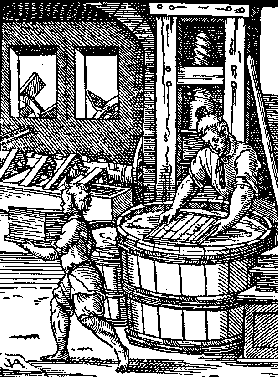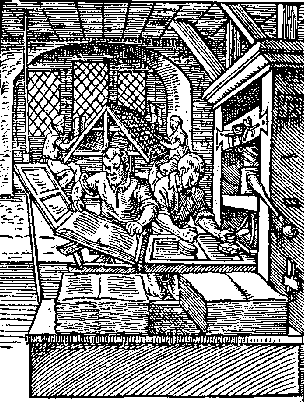Medieval Papermaking
The following description and
illustrations of medieval papermaking are taken verbatim from the World Wide Web
site ORB: The Online
Reference Book for Medieval Studies and is part of an original essay
submitted to the site. The required copyright notice follows the article.
Medieval and Renaissance Book Production - Manuscript Books
Richard W. Clement
… At about this same time, paper became available for use in book production. Though less durable and more difficult to write on than parchment, paper had one great advantage – it was cheaper. Paper was, of course, invented in ancient China, but it was not common in Southern Europe until the thirteenth century. Certainly by the fourteenth century, it was readily available to anyone at a reasonable price.
Paper was made from rags, usually linen. The rags were dampened and left to rot for four or five days. They were then placed in a stamping mill which transformed the rotting rags into a pulp of long fibers. The pulp was then transferred into a large vat (usually of about 330 gallons) which was kept agitated and warm. At least two workers were required for the papermaking operation, a vatman and a coucher. The vatman took one of two moulds (an oblong rectangular wire sieve mounted on a wood frame), fitted the deckle (a removable wooden rim which could be fitted on to the mould to make it into a tray-like sieve with a raised edge), and then dipped it into the vat so that the pulp-solution drained through the mould. This left a layer of matted fibers on the mould as the water drained away. The vatman removed the deckle from the mould and handed the mould to the coucher. The coucher rolled the newly-made piece of paper onto a piece of felt, and then handed the mould back to the vatman. Meanwhile the vatman had prepared another piece of paper with the second mould and the deckle. Together they could produce a sizable quantity of paper over a relatively short period of time – about five and one half reams a day.

The pile of wet paper and felt, known as the post, was subsequently placed in a screw press, and much of the water was pressed out. It took an immense amount of pressure to press out the water and all of the workers in the mill had to turn out to help pull the long wooden lever which turned the screw. The pile of paper was reduced in thickness from about two feet to six inches. A third workman, the layman, freed up each sheet of paper, removed the felts, and placed the paper in a neat pile. This pile was again subjected to pressure and more water was removed. This process was repeated several times. The paper was then taken in groups of four or five sheets, which were dried suspended from ropes in a specially constructed drying loft. Drying the sheets in groups kept them from wrinkling.

Next the paper might be sized. If so, it was dipped into a vat containing animal size, a glutinous liquid made by boiling parchment or leather shavings in water. Size gives paper a relatively impermeable surface. This is essential for writing with a pen, but much less so for printing. After sizing, the paper was once again dried. Finally the paper was subjected to a finishing process. Each sheet was burnished by rubbing it with a smooth stone. This produced a smooth surface and closed the pores of the sheet so that the writing ink would not bleed. …
Copyright (C) 1997, (Richard W. Clement). This file may be copied on the condition that the entire contents, including the header and this copyright notice, remain intact. A previous version of this article appeared as "A Survey of Antique, Medieval, and Renaissance Book Production" in Art into Life: Collected Papers from the Kresge Art Museum Medieval Symposia, ed. by Carol Garrett Fisher and Kathleen Scott (East Lansing: Michigan State University Press, 1995): 9-47. Copyright permission to reprint it here (though with some alterations) has been secured.